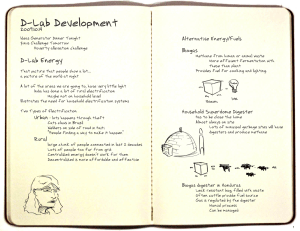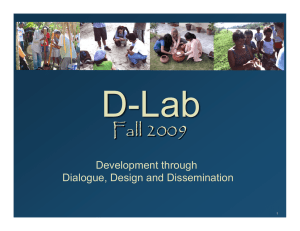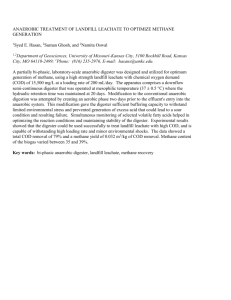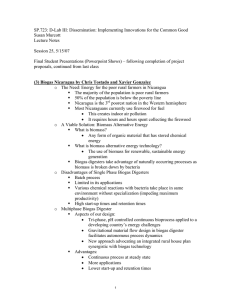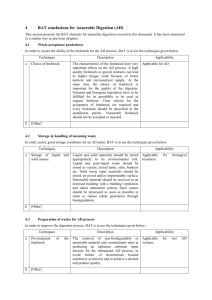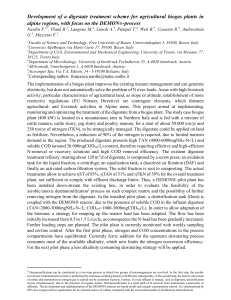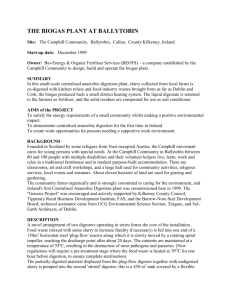Final Construction Project Report for the CRMC Bioenergy Facility
advertisement
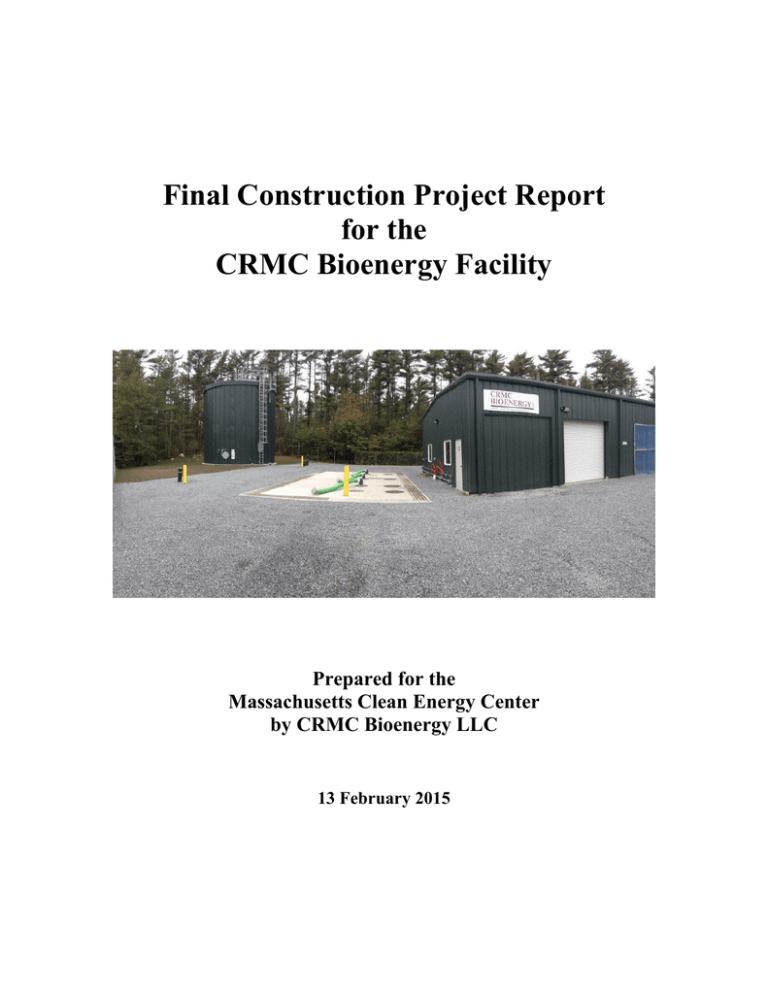
Final Construction Project Report for the CRMC Bioenergy Facility Prepared for the Massachusetts Clean Energy Center by CRMC Bioenergy LLC 13 February 2015 1.0 Introduction This Final Construction Project Report (the Report) provides information to document the start-up of the equipment and systems that comprise the CRMC Bioenergy Facility (the Facility), a recently-constructed anaerobic digestion facility located at the Crapo Hill Landfill, 300 Samuel Barnet Boulevard, New Bedford, Massachusetts (the Landfill). The Report was prepared by the developer, owner and operator of the Facility, CRMC Bioenergy, LLC (CRMC Bioenergy), which is a subsidiary of CommonWealth Resource Management Corporation of Boston, Massachusetts (CRMC). CRMC had received financial assistance, in the form of grant funding for the construction of the Facility, from the Massachusetts Clean Energy Technology Center (MassCEC) pursuant to Task Order 13-1 Between CRMC and the MassCEC dated December 7, 2012 (the Task Order). As indicated in previous submittals to the MassCEC, the grant funding was used by CRMC Bioenergy to pay for a portion of the costs to purchase and install equipment for the Facility. This Report was prepared to satisfy the requirements of Construction Milestone #3 of the Task Order, as set forth in Attachment 3 thereto, which requires CRMC to present the following: • • • A final construction project report template that addresses MassCEC comments on the draft construction project template that had been submitted previously to satisfy the requirements of Construction Milestone #2. Final permits, licenses or amendments thereto not submitted previously to the MassCEC. A report on pilot operations with the purpose of providing useful information to others who may develop a similar facility. CRMC Bioenergy has not received any comments from the MassCEC on the the draft construction project template that had been submitted previously to satisfy the requirements of Construction Milestone #2. Thus, for the purposes of Construction Milestone #2, CRMC Bioenergy is re-submitting the draft construction project template to serve as the final construction project template as Appendix A to this Report. Start-up and commencement of commercial operation of the Facility were completed without the need for additional permits or licenses and without the need for amendments to permits or licenses acquired previously. Thus, no information is required or provided herein to supplement the copies of the permits and licenses provided previously to the MassCEC. In this context, the remainder of the Report provides a brief description of the Facility, then presents information on pilot operations with the purpose of providing useful information to others who may develop a similar facility. Final Construction Project Report for the CRMC Bioenergy Facility Page 2 2.0 Description of the Facility The Facility was designed and developed to use anaerobic digestion technology to convert organic waste materials into biogas. Organic waste materials acceptable for processing at the facility include food waste; fats, oils and grease (FOG); and sludge from wastewater treatment facilities. To be accepted at the Facility, all such materials must be in liquid, pumpable form, with minimal solids and inorganic solid contaminants. The anaerobic digestion process converts the incoming organic materials into biogas, which is typically comprised of approximately 70 percent methane by volume. Note that the Facility is located adjacent to an existing operational facility that generates electricity by combusting gas extracted from the Landfill in any of four internal combustion enginesgenerator sets (the Generating Facility). Biogas from the Facility is piped to the main source of landfill gas to the Generating Facility, where the gases are mixed prior to combustion in the engines and generation of electricity. Materials not converted to biogas are pumped out of the Facility in the form of liquid digestate. The digestate is returned to the Landfill, where it is projected to stimulate production of additional landfill gas for capture by the existing landfill gas collection system. Digestate might also be diverted for use as an additive to on-site yard waste composting operations; as a liquid feedstock in the production of alternative daily cover material (e.g., Posi-Shell) for use at the Landfill; or, as a last resort, for discharge to the municipal sewer through an existing connection. The Facility can be divided into the following major components as discussed herein: • • • • • The receiving area, where incoming organic materials are off-loaded from liquid waste hauling vehicles into any of three feedstock tanks. The mixing tank, where feedstocks from the three tanks can be mixed and heated prior to injection into the digester. Heat for this purpose is recovered from the engine jacket cooling systems of the Generating Facility. The mixing tank and associated pumps, piping and controls, as well as a small laboratory bench for materials testing, are located within a new extension to the existing building that houses the Generating Facility. The digester, which is a 100,000-gallon tank in which the organic materials are mixed hydraulically to facilitate the digestion process. Biogas piping, valves and controls to convey the biogas from the digester to the main source of landfill gas to the Generating Facility. A digestate tank and pumps, piping, valves and controls either to return the digestate to the Landfill, to move it to locations for its other potential uses or for discharge to the sewer. The figure on the cover of this report clearly shows the receiving area, the digester tank (on the left in back) and the extension of the Generator Facility building that house the mixing tank and associated pumps, piping and controls. Final Construction Project Report for the CRMC Bioenergy Facility Page 3 3.0 Information on Pilot Operations Consistent with guidance set forth in the Task Order, the Report consists of sections that address the following topics: I. Digester start-up. II. Review of system components III. Summary of key operating parameters at steady state. IV. Uses/disposal of all outputs. V. Difficulties encountered and how addressed. VI. Description and results of any experimental operations. VII. Plans for maintaining or modifying operations VIII. Annualized estimates of input and output quantities. I. Digester Startup The startup of the Facility involved (1) commissioning tests (i.e. mechanical testing of facility systems and equipment that comprise the Facility), and (2) charging the Facility using organic feedstock materials to bring the Facility from an initial state to a steady state of operations. Mechanical testing. The commissioning tests were conducted during the period September 1 to September 30, 2014, and were the subject of a commissioning report submitted to the MA CEC as part of the Construction Milestone #2. The primary objective of the testing was to determine if the tested equipment and systems operated, or demonstrated that they were capable of operating, in accordance with the Facility design and performance parameters. A related corollary objective of the commissioning was to correct, repair, or replace as appropriate, any individual mechanical (including piping), electrical or control system components in which defects in operations and/or performance were detected. The entire system was charged with water, and raised as necessary to operating temperatures and pressures to observe system, sub-system and/or component performance across expected modes of Facility operations. However, because the system was not charged with digestible organic materials, measurement of actual biogas production was not possible. Charging the Facility. The charging of the Facility using organic feedstocks was conducted during the months of November and December 2014. During the month of November organic feedstock materials were received, mixed, heated and fed into the digester, and the conditions within the digester were monitored and controlled to support the mesophilic anaerobic digestion process. By the end of November, the digester was filled to its 90,000-gallon operating level. Organic feedstock materials included digestate from an anaerobic digestion facility located in Fairhaven, Massachusetts, wastewater treatment sludge, and food waste slurry from a food processing plant. The digestate from the Fairhaven digester was used Final Construction Project Report for the CRMC Bioenergy Facility Page 4 as a seed material to start the Facility’s anaerobic digestion process. The Fairhaven digester was an established digester operating at steady state and the digestate used from this digester contains all the required microorganisms and buffering capacity of a steady state operation. The wastewater treatment sludge and food waste slurries contained the organic material needed to feed the microorganisms at loading rates that would maintain the condition of the digestate in order to bring the digester to its steady state operation. By the end of November 40,000 gallons of digestate and 50,000 gallons of wastewater treatment sludge and food waste slurries had been added to the digester to bring the digester up to its 90,000-gallon operating level. After the digester reached its operating level, the addition of digestate seed material was discontinued. During the month of December, wastewater treatment plant sludge and food waste slurries were added daily during the weekdays to continue the feeding of the digester and to increase the organic loading toward a steady state operation. During December, digestate was removed automatically from the digester through an overflow pipe at the 90,000-gallon operating level of the digester. The digestate was removed at the same rate as the feedstock added to the digester. The digestate was pumped and injected into two horizontal perforated pipes near the top of a closed and capped area of the Crapo Hill Landfill. As a back-up to the landfill injection, digestate was directed to the sewer. During this startup period, the temperature of the materials within the digester was continuously monitored and controlled to maintain a digestate temperature of 98 degrees Fahrenheit, the temperature at which mesophilic anaerobic digestion occurs. All of the feedstocks were mixed and heated to 98 degrees prior to being fed into the digester. All feedstocks were analyzed for pH, moisture content, solids content, and volatile solids content. The volatile solids were used as the measure of organic content to determine the mix of feedstocks and the organic loading rate (OLR) into the digester each day. The OLR into the digester was maintained in the range of 0.5 to 1.5 kilogram of volatile solids per cubic meter of material in the digester per day. The material within the digester, the digestate, was measured each day to monitor the performance during start-up. To determine the performance, daily samples of digestate were measured for pH, alkalinity, volatile fatty acids, FOS/TAC ratio (VFA/Alkalinity). Furthermore, the conditions of the digester were measured continuously including digester temperature, biogas methane composition, pressure and flow. II. Review of system components The major system components include the receiving area, feedstock storage tanks, mixing tank, heat exchange equipment, and the digester. Receiving area and feedstock tanks: A 20-foot by 42-foot concrete pad comprises the receiving area. This area provides sufficient space for liquid waste hauling vehicles to park, and connect to above ground 6-inch diameter cam lock fitted hoses that serve three Final Construction Project Report for the CRMC Bioenergy Facility Page 5 12,000 underground feedstock storage tanks. The 6-inch diameter cam lock fitted hoses have been effective at allowing the gravity feed of a 9,000 gallon liquid waste hauling vehicle to transfer the full contents of material within 15-minutes. At the end of each hose located at the entrance to each tank, a stainless steel screen with ½-inch by ½-inch holes provides screening of solid contaminants that may be contained in the pumpable liquids being delivered. The screens have been effective at screening trash from deliveries. Each tank contains a submersible chopper/grinding pump that has been effective at size reduction of materials, recycling feedstocks within each tank for mixing, and delivery of feedstocks to the mixing tank. The receiving area’s concrete pad is heated using recovered waste heat from the jacket water of two internal combustion enginesgenerator sets. Heated anti-freeze fluid flowing through PEX tubing heats the concrete pad. The receiving area has been maintained in a moisture free condition as a result of the heating. Mixing tank and heat exchange: A 6,000-gallon polyethylene-mixing tank is contained within the building that contains the process equipment including the mixing tank, pumps, piping, valves, monitoring and controls, and laboratory equipment. The feedstocks are fed sequentially to the mixing tank to levels that are adjusted to predetermined levels to make the desired feedstock recipe each day. The feedstocks are circulated through the heat exchanger with heat exchange rates of up to 1 MMBtu per hour. The feedstocks are heated from the temperature in the tank to the digester temperature of 98 degrees Fahrenheit. The process of filling the mixing tank to between 3,000 to 4,000 gallons and heating the content to 98 degrees F typically takes approximately 45 to 60 minutes. The feedstock is then fed into the digester in one of two ways: First, the feedstock is fed through the feedstock chopper pump directly into the digester through a dedicated pipe, which takes between 30 minutes with the feedstock chopper pump at full capacity and 120 minutes with the feedstock chopper pump at half capacity. Second, a separate pump has been added to feed the feedstock at a low rate of 4 gallons per minute through the hydraulic mixing system of the digester rather than the separate feedstock chopper pump. This separate pump has added the flexibility to continuously feed the digester over a 24-hour basis. This slower continuous feed option has allowed feeding the digester with higher organic content without risking overloading the digester with organics during a short duration. During the startup period, the controls for automating the filling of the mixing tank, the heating of the feedstocks, and the heat exchange between the waste heat of the engines and the feedstock materials were adjusted so that the monitoring and controls work reliability in an automated operating mode. Final Construction Project Report for the CRMC Bioenergy Facility Page 6 Digester operations. Heating the digester. The heating system that includes a feedstock chopper pump and heat exchanger provides heating to the digester. When the digester requires heating to maintain the digestate temperature of 98 degrees Fahrenheit, the feedstock chopper pump extracts digestate from the digester and circulates the digestate through the heat exchanger until the digester temperature reaches its set point. This heating control has worked reliably to maintain a constant temperature in the digester. The heat is extracted from the waste heat contained in the jacket water circuit from two of the four internal combustion enginesgenerator sets. The waste heat from either one of the engines is sufficient to operate the heat exchanger to heat the digester, feedstock and receiving area during the coldest weather events this winter. During the startup period, the controls for maintaining the digestate operating temperature were adjusted so that the monitoring and controls work reliability in an automated operating mode. Hydraulic mixing of digester. The hydraulic mixing system includes a digestate chopper pump, several nozzles contained within the digester, piping and valves, and monitoring and controls. Hydraulic mixing occurs within the digester by extracting digestate from the digester through the digestate chopper pump and recycling the digestate back to the digester. Within the digester the recycled digestate is conveyed through two hydraulic nozzles set at the bottom of the digester to thoroughly mix the digestate, one nozzle located two feet below the top surface of the digestate to prevent the buildup of a scum layer at the top (scum buster nozzle), and one nozzle above the top surface of the digestate used to prevent foaming (the foam busting nozzle). During the start-up period, various operating modes of hydraulic mixing were tried including timed periods of the hydraulic system shutoff, turned on at partial load, and turned on at full load. The various modes of hydraulic mixing had varied impacts on the production of biogas and hence microbial activity within the digester. Performance as measured by biogas production has shown that the hydraulic mixing at the highest capacity results in the highest biogas flow rates produced from the digester. The operating mode that appeared to result in the highest level of biogas production was operating the hydraulic mixing system continuously on a timed cycle; 1 hour at a 50 to 60 percent capacity and 1 hour at 100-percent capacity. This operating mode appears to mix the digestate thoroughly and maintains the microbial activity. Operations have shown no evidence of scum build-up or foaming events within the digester. Biogas. Biogas within the digester is maintained at a pressure level of approximately 10 inches water gauge. A valve in the biogas piping between the digester and the engines fuel system is programmed to make open and close adjustments to maintain the 10 inches of water gauge pressure set point. During Final Construction Project Report for the CRMC Bioenergy Facility Page 7 the startup period the control was refined so that this adjustment works rapidly and reliably. Digestate. Digestate that flows to the digestate storage tank is pumped daily to the landfill. Changes to the straining and pumping equipment during startup have made this process reliable (See Section V). Odor controls. All of the underground feedstock tanks, digestate tank, and the mixing tank are vented to the combustion air intake of two of the four internal combustion engines-generator sets. The vent is under vacuum from the draw of the combustion air intake to the engines. In addition, an inline blower adds further vacuum and flow from each of the tanks. As a result of this control system, no fugitive odors have emanated from the tanks during anytime of operation, and no fugitive odors have emanated from the engine exhaust. Therefore use of the engine combustion air, as a control for odors, is a reliable method of odor control and compatible with the Facility. III. Summary of key operating parameters at steady state The performance of the digester is monitored daily by measuring key operating parameters including the digestate pH, volatile fatty acids content, alkalinity content, ratio of VFA to alkalinity (FOS/TAC ratio), digestate solids and volatile solids content, temperature and biogas composition and quantity. After the digester was filled and a steady state operation was attained, the performance parameters for the two products, biogas and digestate, are shown in the Table 1 below. Table 1: Digester Product Performance Data Readings Range Products Performance parameter at Steady State Biogas Digestate Target Value Acceptable Range Methane content 69 to 75% 70% 60+ % Flow rate, scfm 5 to 20 25 10 to 30 Temperature, F 96 to 99 98 95 to 105 pH 7.2 to 7.4 7.0 6.5 to 7.6 FOS/TAC Ratio 0.04 to 0.15 0.15 0.05 to 0.30 Volatile fatty acids as acetic acid mg/L 300 to 700 500 Alkalinity as calcium carbonate, mg/L 5,000 to 8,300 5,000 Final Construction Project Report for the CRMC Bioenergy Facility Page 8 Products Readings Range Performance parameter at Steady State Target Value Solids content, % by weight 0.9 to 1.0% 0.9 Solids that are volatile, % by weight 67 to 75% 70% Acceptable Range The parameters of the feedstock inputs used during the startup period are shown in Table 2 below. The four feedstocks shown below were fed into the digester in several combinations depending on availability of the feedstock and the desired mix of materials. During the month of November, 40,000 gallons of digestate from Fairhaven was received and fed to the digester and 56,000 gallons of a mix of feedstocks from those in Table 2 were fed to the digester. During the month of December, approximately 67,000 gallons of a mix of feedstocks were fed into the digester. The changes in feeding the digester will result in being able to feed the digester at a rate of approximately 90,000 gallons per month. Note that resulting digestate parameters shown in Table 1 compared to the feedstock parameters in Table 2 show that the digester is performing well by reducing the organic loading and solids content contained in the feedstock to a low organic and solids content in the digestate, and maintaining relatively consistent FOS/TAC ratios and pH, all within the desired range. With the ability to feed the digester higher quantities of feedstock containing higher organic content, the Facility will be able generate higher quantities of biogas and digestate in the future. Table 2: Feedstock Parameters Parameter pH Units Feedstocks Sanitary Slurry Slurry waste Slurry waste Sludge waste #1 #2 #3 6.08 4.96 5.67 4.64 as calcium Alkalinity carbonate, mg/L as acetic acid Volatile fatty acids mg/L 776 10,659 1,802 1,351 1,025 40,114 3,884 6,473 FOS/TAC Ratio 1.32 3.76 2.16 4.79 Moisture content % by wt. 98.4% 92.1% 93.2% 89.5% Total solids % by wt. 1.6% 7.9% 6.8% 10.5% Volatile solids % by wt. 1.5% 5.9% 6.2% 10.4% Volatile solids % of total solids 94.9% 75.1% 91.8% 99.3% Final Construction Project Report for the CRMC Bioenergy Facility Page 9 Biogas The composition of biogas was monitored initially daily and after a couple of weeks, continuously. After the second day of start-up, biogas was measured at 1.4% methane content within the digester. After 15 days of start-up, the biogas composition attained a steady state composition of 72-percent methane content and 28-percent carbon dioxide. The pressure exerted within the digester by the biogas production was sufficient that after approximately 10 days, biogas began flowing from the digester to the fuel system at the Generating Facility. The digester gas pressure was maintained at 10 inches by controlling a valve that allows flow from the digester to the engine fuel system. Biogas started flowing at approximately 5 scfm initially and with increasing organic loading rate, biogas flowed to as high as 20 scfm. The biogas production during the start-up period coincided with the addition of feedstocks into the digester. Feedstocks were mixed and heated during the morning and added to the digester over a 1-hour period of time on a daily basis during the weekdays. Biogas production would peak during a 6 to 8 hour period after the feedstock was added to the digester and then would reduce to a low level until the next feedstock was added. The biogas was mixed with landfill gas to the fuel the four internal combustion engines-generator sets. Power consumption and savings During normal operations during cold weather, the Facility consumes power at a rate of approximately 8,600 kWhr per month. The Facility reduces the power consumption of the adjacent Generating Facility by approximately 5,800 kWhr by reducing the motor usage of the two air cooled radiators that regulate temperature on two of the internal combustion engines-generator sets. This reduction is directly attributable to the use of waste heat from these two radiators. Therefore the net incremental in-plant power consumption of the Facility after considering the reduction in plant power of the Generating Facility is approximately 2,800 kWhr per month. Digestate injection into Landfill. Digestate was injected into the Landfill during November and December 2014. The quantity and duration of injection of digestate into the horizontals perforated pipe close to the top portion of a closed and capped area of the landfill is not sufficient to provide any meaningful data yet as to the impact of the generation of landfill gas in the area of the digestate injection. It is anticipated that quantifiable results can be obtained over the next six months. IV. Uses/disposal of all outputs The outputs from the digester include digestate and biogas. The quantity of digestate generated during the startup period was 4,263 gallons during the month of November, and 67,435 gallons during December 2014. The primary use of the Final Construction Project Report for the CRMC Bioenergy Facility Page 10 digestate has been to inoculate a closed and capped area of the adjacent landfill by injecting the digestate into existing horizontal perforated pipes close to the top of the landfill. The quantity of digestate that has been injected into the landfill during the startup period was 4,263 gallons during November 2014, and 36,944 gallons during December 2014. As a backup to injecting digestate into the landfill, digestate has been discharged to the sewer. With the ability to feed higher quantities of feedstock with higher OLR into the digester in the future, the Facility will be able to increase quantities of digestate to approximately 90,000 gallons per month. During the startup period, biogas was generated at a rate of between 5 to 20 scfm at 70percent methane content. The biogas is delivered to the fuel system of the engines, mixed with landfill gas and combusted in the engine-generator sets to make power. In the event that the engines are not operational for any reason, the biogas is delivered to the existing flare to be combusted. The quantity of biogas generated during the startup period was 49 MMBtu during the month of November, and 203 MMBtu during December 2014. The ability to feed into the digester higher quantities of feedstock with higher organic content will allow the Facility to be able to increase quantities of biogas to approximately 600 MMBtu per month. Note that during the month of December, an estimated 18,000 kWhr of electric power was produced by the Generating Facility from the use of the biogas generated by the Facility. The net incremental power production after accounting for the incremental inplant power consumption due to the Facility was approximately 15,200 kWhr for December. During the month of January, the biogas generation increased to a level that produced an estimated 30,000 kWhr of electric power by the Generating Facility or a net of 27,200 kWhr. The Facility has the capacity to increase biogas to even higher levels based upon digesting higher organic material content. V. Difficulties encountered and how addressed Feedstock issue: One of the feedstocks accepted during startup was a slurried waste from a food processor that contained polymer that exceeded normal quantities. The excess polymer resulted in coagulating and solidifying a significant quantity of the material and separating the thickened material from the liquid. This occurred in two of the feedstock storage tanks, which made pumping the feedstock problematic. CRMC Bioenergy added piping and valves to the process system to enable the operator to heat feedstock material and return the material into the feedstock tanks at elevated temperatures to increase solubility of coagulated and solidified feedstock material. CRMC Bioenergy also added piping and valves to the process system to enable moving feedstock materials between any of the storage tanks in order to mix dilute feedstock material with thick feedstock material to increase solubility of coagulated and solidified material. CRMC Bioenergy also stopped accepting the feedstock containing the excessively high polymer quantities. Digestate injection pump: The original design of the digestate injection system was to use a centrifugal pump to convey digestate to the landfill. The centrifugal pump became clogged with small quantities of fine fibrous material contained in the digestate that Final Construction Project Report for the CRMC Bioenergy Facility Page 11 required frequent dismantling and cleaning of pump to make it operational. A strainer was installed prior to the centrifugal pump but did not fully solve the problem. CRMC Bioenergy addressed the issue by replacing the centrifugal pump with a rotary lobe positive displacement pump. The replacement pump has worked reliably without the need to dismantle and clean since its installation in mid-December. Feedstock feed to Digester. The initial equipment to feed feedstock material into the digester limited the feed time to a 30 to 120 minute batch each day, which resulted in high biogas generation for 6 to 8 hours but low biogas generation until the next feeding batch cycle. Also short duration batch cycle of feed created a concern for overfeeding the digester if available higher organic loaded feedstocks were used. CRMC Bioenergy addressed the issue by adding a low volume feed pump that has the capacity to feed at varied rates between 1- to 4-gallon per minute continuously to the digester. This addition provides the Facility to increase the OLR into the digester and generate a more consistent production of biogas ultimately in the range of 20 to 30 scfm at 70% methane content. Availability of food waste. Obtaining sources of food waste that are in a form that can be transported by liquid waste haulers and used at the Facility is problematic. Even though the MA DEP instituted a ban on the disposal of food waste in landfills and WTE facilities, the regulated sources do not generate or set out food waste in a form that the Facility can accept. Potential sources that CRMC Bioenergy have been in contact with simply do not have food waste that is in depackaged and slurried form. Potential sources of food waste are reluctant to perform depackaging at their facilities and further reluctant to add technology to convert depackaged solid food waste to pumpable slurry. The reluctance is two-fold. First, sources of food waste do not want to process food waste at their source for fear of contamination of their food products. Second, sources of food waste do not want to incur additional cost for the transformation, transportation and disposal over their current costs of transport and disposal at landfills and waste-to-energy facilities. To exacerbate the situation, news that MA DEP is providing waivers from the waste ban regulations to regulated sources or is delaying enforcement against regulated sources is delaying the regulated sources from moving forward to comply with the waste ban. CRMC Bioenergy is addressing this issue by working with technology vendors to offer regulated sources of food waste with the technologies needed to convert depackaged waste to slurry form. Also CRMC Bioenergy is in the process of identifying sites and technologies that could be developed into a regional depackaging and slurry operation to facilitate the receipt of packaged food waste from regulated sources. VI. Description and results of any experimental operations None. VII. Plans for maintaining or modifying operations Assuming that the expectations of CRMC Bioenergy are met for obtaining organic feedstock materials, biogas generation, and digestate management, CRMC Bioenergy Final Construction Project Report for the CRMC Bioenergy Facility Page 12 intends to increase the capacity of the Facility by adding substantially more anaerobic digestion capacity. VIII. Annualized estimates of input and output quantities Inputs to the Facility are estimated to be approximately 1 million gallons annually of feedstock. Outputs from the Facility are estimated to be approximately 1 million gallons per year of digestate and 7,200 MMBtu per year of biogas. Final Construction Project Report for the CRMC Bioenergy Facility Page 13 APPENDIX A FINAL CONSTRUCTION PROJECT TEMPLATE Final Construction Project Report for the CRMC Bioenergy Facility Page 14
